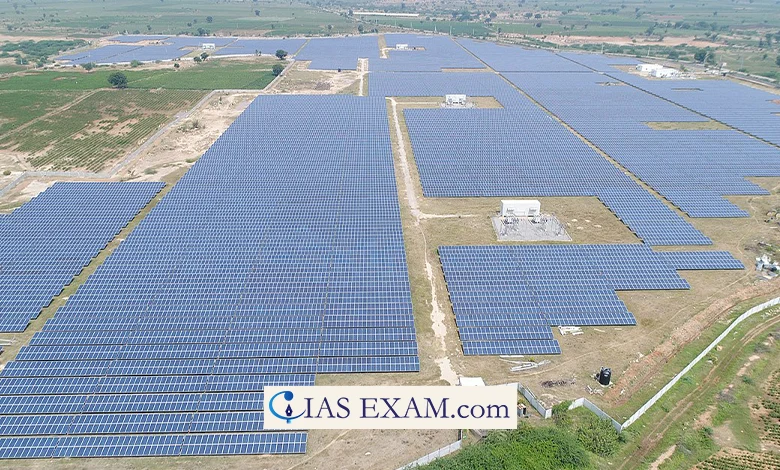India is now third largest producer of solar power
Syllabus: Science and Technology [GS Paper-3]

Context
As of 2023, India surpassed Japan to become the world’s third-largest producer of solar power. This remarkable feat reflects India’s commitment to renewable energy and its rapid growth in the solar sector
Key Points
- Solar Generation:
- India has turned out electricity at 113 billion units (BU) from only solar power which is greater than what Japan did in 110 BUs during 2023.
- Solar energy has grown into an influential component of the electricity generation capacity of the country.
- Potential vs. Actual Production:
- While the installed capacity is performance after performance in India, the original power can deviate sometimes as it is affected by changes in demand levels and local factors like the weather conditions.
- While solar power currently takes up 18% of total installed capacity at 442 GW (58.22%), it merely contributes to about 6% of the total power production. Exactly two thirds of the preferential tariffs to the power actually produced.
- Reasons for Overtaking Japan:
- In that year, despite decreasing by -2% (2 BU), Japan was at fourth place behind India that was relatively even with it.
- Sustaining this movement would increase solar production for India that is more than 228 BU and overtake the United States that would remain in the second spot as of now, with even less production.
Global Context:
- And still China remains as the world largest producer of solar power, generating a remarkable 584 TWh by the year of 2024 – efs, more than all next four countries (America, Japan, Germany and India) combined together.
- Accessibly, renewable sources of power today provide 30% of energy globally and wind and solar activities pull the wind.
Factors Contributing to India’s Success
Several factors have contributed to India’s success in the solar power sector:
- Decreasing Solar Tariffs: The cost of solar power has decreased significantly over the years, making it more competitive with fossil fuels.
- Increased Investment: India has seen a significant increase in investment in the solar power sector, with both domestic and foreign companies investing heavily in the sector.
- Improved Technology: Advances in technology have improved the efficiency of solar panels, leading to more power generation and reducing costs.
- Government Support: The government’s policy initiatives and support have created a favourable environment for the growth of the solar power sector.
Implications of India’s Emergence as the Third Largest Producer of Solar Power
- Reduced Dependence on Fossil Fuels: India with solar power searches will limit fossil fuels which will result in decrease of greenhouse gases and will lead to a cleaner environment.
- Energy Security: Besides the numerous jobs Solar power will create, one of the most important roles it will play is to ensure energy security for India, which is imperative for economic growth and development.
- Job Creation: A growing solar production field will give an influx of new jobs in the country, both directly and indirectly.
- Economic Benefits: Solar power industry is sun shady, quite accurate to create a wealth of economy, which in turn can draw more investments and earn revenue.
Conclusion
India’s emergence as the third largest producer of solar power is a significant achievement, and the country is likely to continue playing a leading role in the global renewable energy landscape. The government’s support, decreasing solar tariffs, increased investment, and improved technology have all contributed to this success. While there are still challenges to be addressed, the future prospects for India’s solar power sector are bright, and the country is likely to continue making significant progress in the field of renewable energy.
Source: The Economics Times
UPSC Mains Practice Question
Q. Discuss the factors contributing to India’s rapid growth in solar power production, including governmental initiatives such as the Jawaharlal Nehru National Solar Mission (JNNSM), regulatory frameworks, incentives, and private sector involvement.





.png)



